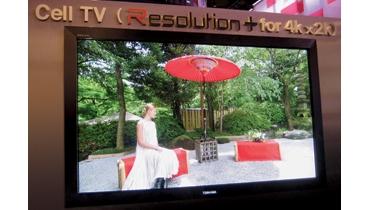Tech Trends '09: Special K

In a wintry scene on a certain Blu-ray Disc I'm watching, I can see subtle shadings in the whites of the snow-covered yards. All around, contrast is crisp, and color is stunning - such as the perfect-hued skin tones of the leading man's face. Not to mention the brilliant shade of azure in his matching scarf and hat. (Has such a tint ever appeared onscreen before?)
And clarity? Nine feet from my 50-inch Pioneer plasma HDTV, I can make out hints of roughness on the face of the lovely co-star - and my TV doesn't even do 1080p! But this isn't some multi-hundred-million-dollar epic. It's Zack and Miri Make a Porno, fer Chrissakes. And it stars Seth Rogen! Still, could this scene possibly look any better?
Well, high-def pictures could get more than four times clearer - roughly 7 million pixels better than the current 2-ish million. That's the resolution of the 4K digital-cinema projection specification. And if enough of you demand 4K, it could be yours. The questions are: Do you really want it? Do you really need it? And how long might you have to wait to get it?
PIXEL MUMBO JUMBO
But before you decide to go to 4K-Mart for a high-def upgrade, you might want to become an educated consumer. If you have a TV and a source (such as Blu-ray) that are both full-HD, you're viewing the 1080p format - meaning that your picture resolution is 1,920 pixels wide by 1,080 pixels high for a total of 2,073,600 pixels. At this rez, depending on your TV, a movie can look as good as it did projected in the theater - as long as the screen isn't gargantuan and you don't sit too close or too far away.
But what if you do have a jumbo TV? Maybe you're cool enough to have a dedicated screening room with a front projector and a truly big screen. Watching a movie at such a size, an astute viewer could probably tell that the picture quality isn't quite comparable to that of a new film print unspooling at a first-rate cinema. That's because 35mm motion-picture-film resolution roughly translates to 4K. And as I said, that's about 9 million pixels.
Now, if there were a home video format that could milk every grain from 35mm motion-picture prints, you'd have an essential clone of the movie's master print. That's what a 4K digital telecine transfer can do.
But how much more special would those extra millions of pixels make your life? For S&V technical editor Al Griffin, a demo of Meridian's 10-million-pixel Model 810 front projector at this year's Consumer Electronics Show "was one of the highlights for me," he says. "The picture quality was fantastic - on par with what I'm used to seeing at good movie theaters." And keep in mind, Griffin wasn't even watching a native 4K source, but rather an upscaled 1080p signal: The Dark Knight on Blu-ray.
Why did Meridian create this reference-quality consumer projector at a time when there isn't even any native 4K material to show on it? "Because we could," says Meridian director of business development Roland Morcom. "To enhance resolution is something we've learned with our audio products. And resolution enhancement - improving the quality of rendering - is really very similar in the video realm."
Flat-panel 4K displays actually made their debut at last year's CES, where Sony previewed an 82-inch LCD screen ("like looking through a window, literally," said Al Griffin at the time), as did Samsung. And Panasonic showed a 4K panel whose resolution was often overlooked because the TV measured 150 inches. Meanwhile, at CES 2009, Toshiba unveiled its prototype "cell processor"-driven 56-inch 4K LCD TV. But none of these TVs are yet ready for prime time.




























































